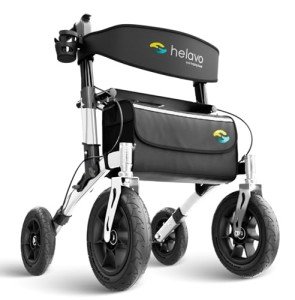20 Fun Facts About Stable 4-Wheel Walker

The Stability of 4-Wheel Walkers: A Comprehensive Guide
A stable 4-wheel walker can transform mobility for individuals experiencing difficulties with balance and coordination. These gadgets, often called rollators, can be essential tools in restoring independence for those recovering from surgical treatment, getting rid of age-related restrictions, or handling persistent conditions. This blog site explores the features, advantages, and factors to consider one should remember when choosing a 4-wheel walker, supplemented with useful tables and a Frequently Asked Questions (FAQ) area to enhance understanding.
Why Choose a 4-Wheel Walker?
A 4-wheel walker provides a number of benefits over standard walking aids, such as walking canes or walkers with only 2 wheels. Below are some of the key advantages:
Benefits of a 4-Wheel Walker
| Advantage | Description |
|---|---|
| Enhanced Stability | The four wheels supply a stable base, enabling simpler navigation throughout different terrains. |
| Boosted Mobility | The models are generally lighter and easier to maneuver, enabling users to move with self-confidence. |
| Integrated Sit-Down Feature | Many 4-wheel walkers come with a built-in seat, providing users the alternative to rest when required. |
| Storage Options | A lot of walkers consist of storage bags or baskets for personal products, increasing flexibility for users. |
| Adjustable Height | Numerous models offer height modifications to accommodate numerous user heights, providing comfort throughout use. |
| Braking System | The majority of walkers come geared up with hand brakes, allowing the user to safely stop and lock the walker in place. |
Kinds Of 4-Wheel Walkers
4-wheel walkers can be found in different styles and functionalities to deal with various user requirements. Below is a categorized table:
| Type | Description |
|---|---|
| Standard Rollators | Fundamental designs developed for basic mobility. Frequently lightweight and foldable. |
| Heavy-Duty Rollators | Designs constructed to support larger weights (as much as 500 pounds or more). Perfect for heavier users. |
| Dual Brake Rollators | Offer both hand brakes and parking brakes for boosted security, specifically advantageous for elderly users. |
| Folding Walkers | Compact models that easily fold for transport and storage. Perfect for those who take a trip or have limited space. |
| Specialty Rollators | Geared up with distinct features such as built-in lights, larger seats, or specific designs for specific conditions like arthritis. |
Key Features to Consider
When selecting a stable 4-wheel walker, it is important to choose a model that fits the user's requirements. Here are some vital features to think about:
- Weight Capacity: Always check the maximum weight limitation.
- Height Adjustability: Ensure that it can be adapted to fit the user's height.
- Wheel Size: Larger wheels offer much better capability over rough terrains, while smaller wheels are fantastic for indoor usage.
- Seat Height and Comfort: If the model consists of a seat, examine its height and cushioning.
- Braking Mechanism: Look for reliable brakes that are easy to run.
- Relieve of Folding: Users need to easily fold and unfold the walker for transport.
- Storage Solutions: Evaluate storage alternatives like seat pouches and under-seat baskets.
- Product and Durability: Consider walkers made with durable products to make sure durability.
Popular Models on the Market
Here's a selection of popular designs currently available, showcasing their unique features and specs:
| Model | Weight Capacity | Seat Height | Features |
|---|---|---|---|
| Drive Medical Nitro | 300 pounds | 23.5" | Lightweight, easy-to-fold design, big wheels. |
| Medline Ultralight | 300 pounds | 23" | Integrated seat, adjustable handles, storage pouch. |
| Nova Zoom 4 | 300 pounds | 22-24" | Dual brakes, padded seat, easy to fold. |
| INFANT JOY 4-Wheel | 300 pounds | 20-23" | Lightweight aluminum frame, storage basket, ergonomic handles. |
How to Use a 4-Wheel Walker
Learning how to utilize a 4-wheel walker efficiently is important for making the most of security and mobility. Here's a detailed guide:
- Position the Walker: Stand behind the walker, with the handlebars at hip height.
- Adjust for Comfort: Make sure the height suits your comfort for standing and walking.
- Engage Brakes: Before sitting, engage the brakes to guarantee the walker does stagnate.
- Step Forward: Move the walker forward, ensuring all four wheels are in contact with the ground.
- Stroll Naturally: Use a natural walking rhythm, moving the walker forward and stepping the mechanism as needed.
- Rest: When tired out, find a seat on the walker, engage the brakes, and sit conveniently.
FREQUENTLY ASKED QUESTION
1. What is the ideal height for a 4-wheel walker?
- The handlebars need to be at waist level when the individual is standing straight. Most walkers offer adjustable heights to accommodate this.
2. Can a 4-wheel walker be utilized outdoors?
- Yes, many designs are developed for outdoor usage, including bigger wheels for much better navigation over irregular surfaces.
3. How do you keep a 4-wheel walker?
- Frequently check the wheels, brakes, and frame for wear and tear. Clean surface areas to remove particles, and make sure the brakes function properly.
4. Exist insurance coverage advantages for buying a 4-wheel walker?
- Many insurance strategies cover walkers if prescribed by a health care provider. Always inspect your particular plan information.
5. What is the typical expense of a 4-wheel walker?
- Costs may vary widely, from approximately ₤ 50 for standard designs to over ₤ 300 for advanced styles.
A stable 4-wheel walker can significantly add to an individual's mobility, self-confidence, and lifestyle. By thinking about the features, types, and perfect use techniques talked about above, individuals can make informed decisions that best suit their requirements. Whether Top Performance Rollator 's for recovery, aging, or managing continuous health conditions, picking the right walker can lead to a healthier and more active lifestyle.

